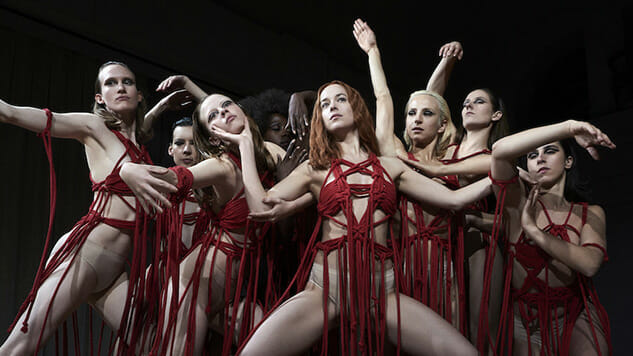Suspiria

Dario Argento’s original, 1977’s Suspiria, synthesized his many experiments with the giallo form—the mid-century thrillers and violent crime stores much of Argento’s peers were churning out—into something essential. Gone were the questions of whodunit, the investigative layer of procedure litigating how such evil could make its way into this world, replaced by both a focus on the victims of this murder mystery and a sensual connection to the horrors flaying their young bodies apart. That the film takes place in Munich’s Tanz Dance Academy, though little dancing occurs, projects the film’s insinuated physicality onto the walls and floor as chimeric splashes of fairy tale color, especially (of course) red—we always remember the red—its vibrancy emphasized by Goblin’s monolithic score. Women, in Argento’s film, are vessels: for life, for gore, for art. Luca Guadagnino’s remake, and David Kajganich’s screenplay, simply tell the audience this—over and over and over. To significantly grosser ends. What Argento implied, Guadagnino makes literal.
In 2018, but in 1977, we begin with a title card and the sounds of revolution: The following is told in six chapters and an epilogue, taking place in “divided Berlin.” Rising star Patricia (Chloë Grace Moretz), manic as she attempts to tell her psychotherapist, Josef Klemperer (Tilda Swinton in convincing enough old-guy makeup, billed as Lutz Uberdorf, because: aren’t celebrities weird?!), of the strange goings-on at the Markos Dance Academy, disappears soon after, which encourages Klemperer to become increasingly suspicious of Patricia’s claims that her dance school is run by a coven of witches, and that her diary, full of occult ravings, should be further studied.
Meanwhile, former Mennonite and Ohioan Susie Bannion (Dakota Johnson) arrives at the Academy in Berlin, ready to audition though she’s had no formal training, no previous notice and no childhood predisposed to such an expressive art. There, in Berlin during the German Autumn, amidst the hijacking of the Lufthansa Flight 181 and the country’s youth taking account, navigating the psychic wounds, of the horrors their parents’ generation inflicted on the world, a naturally gifted young woman finds a mini-society of women to guide her and hone her, independent from the brutal outside world of men, but still dealing with their own, similar, shit.
What Argento slowly revealed, Kajganich admits up front and then explicates: The dance academy is a coven of witches, and here is how that coven operates, from its hierarchy of influence to its flashes of democracy. Apparently Susie’s arrival and Patricia’s disappearance coincide with the coven’s vote on legacies of power, the women divided into two camps: those who support absent matriarch Helena Markos, and those who want the academy’s driving creative force, Madame Blanc (Tilda Swinton), to take over. By narrow margin, Markos wins, such procedural minutiae shot by Guadagnino and cinematographer Sayombhu Mukdeeprom (with whom Guadagnino worked on Call Me By Your Name) as a distillation of Argento’s visual style and other cult, pulpy offerings of the late ’70s, lifting a lot of the mundane weight of all the bureaucracy going on and transforming it into something equally primal and disconcerting.
-

-

-

-

-

-

-

-

-

-

-

-

-

-

-

-

-

-

-

-

-

-

-

-

-

-

-

-

-

-

-

-

-

-

-

-

-

-

-

-








































